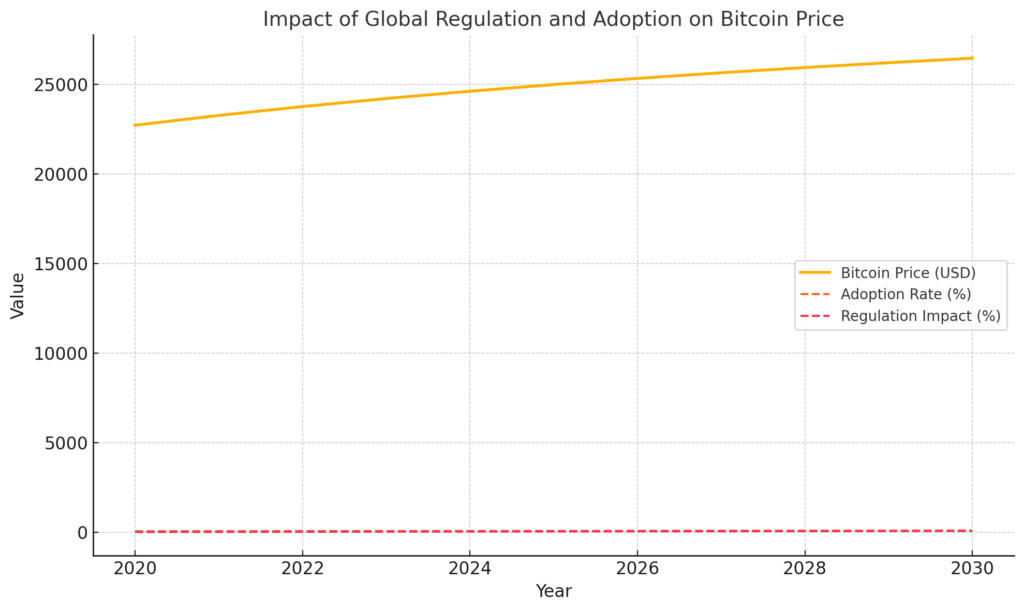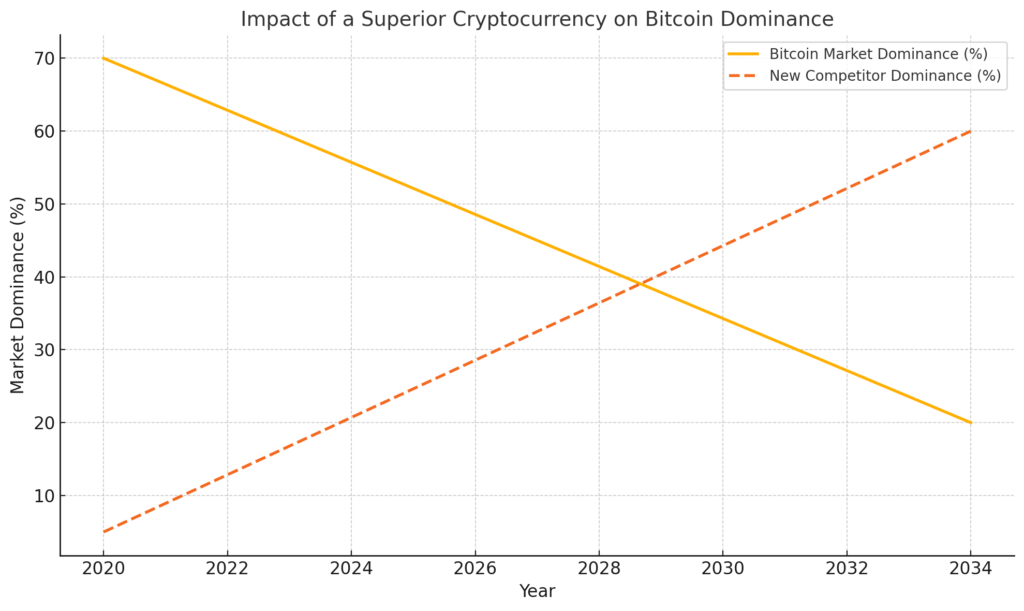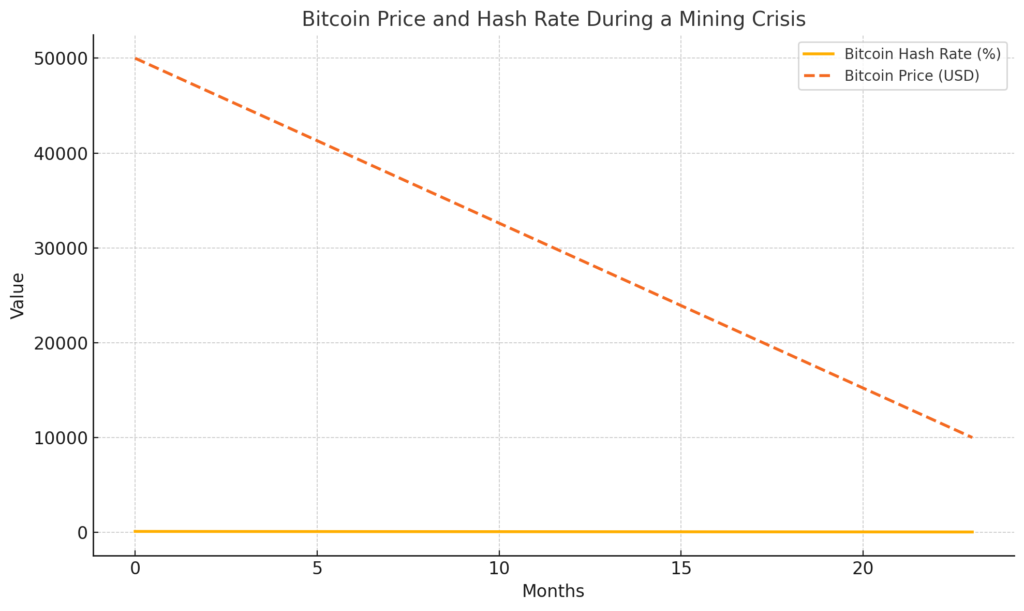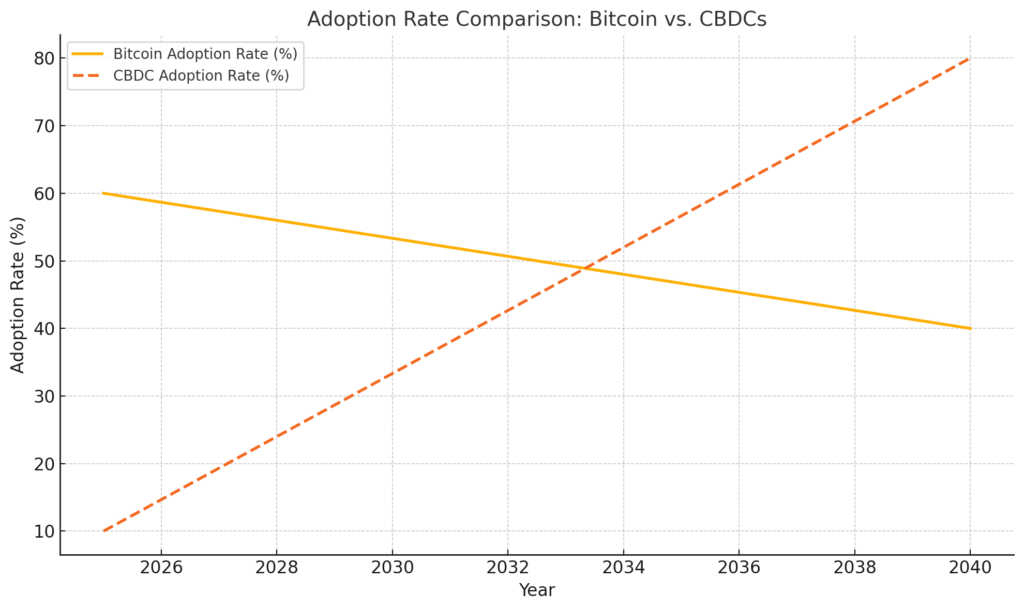Bitcoin has been a revolutionary force in the financial world, but like any innovation, it is not immune to potential vulnerabilities. Here are 10 scenarios that, in theory, could bring Bitcoin to zero. While these scenarios range from plausible to highly speculative, we will explore their implications and conclude with why such a collapse is virtually impossible.
A Global Ban on Cryptocurrencies
Governments around the world could unite to enforce a coordinated global ban on cryptocurrencies, making it illegal to trade, hold, or mine Bitcoin. Such a ban could cut off Bitcoin’s liquidity and use cases.
Governments could pressure major exchanges and financial institutions, resulting in severe market disruptions. Without legal access points, Bitcoin adoption would decline, leaving only a shadow network of users with diminished utility.
Impact of Global Regulation and Adoption on Bitcoin Price

Line graph showing the relationship between Bitcoin price, adoption rate, and regulation impact from 2020 to 2030. Bitcoin price decreases as regulation impact increases, despite a steady rise in adoption rate
Quantum Computing Breakthrough
A significant advancement in quantum computing could render Bitcoin’s cryptographic security obsolete. Quantum computers could theoretically break the SHA-256 encryption used in Bitcoin mining, undermining its security.
If Bitcoin transactions and wallets become vulnerable to quantum attacks, trust in the network would evaporate. Investors would likely abandon Bitcoin for more secure alternatives, leading to a rapid devaluation.
Potential Impact of Quantum Computing on Bitcoin Security

Line graph illustrating the potential impact of quantum computing on Bitcoin security from 2020 to 2040. As quantum computing power increases, Bitcoin security shows a steady decline.
Complete Loss of Public Trust
Bitcoin’s value is underpinned by public confidence in its decentralized and secure nature. A massive security breach or fraud scandal involving Bitcoin’s core technology could shatter this trust.
If users and investors no longer perceive Bitcoin as a safe and reliable store of value, they may flee to alternatives, causing the price to plummet.
Dominance of a Superior Cryptocurrency
The emergence of a cryptocurrency that is vastly superior in technology, scalability, and utility could render Bitcoin obsolete. If the new cryptocurrency gains widespread adoption, Bitcoin’s relevance could fade.
Bitcoin’s perceived value as “digital gold” could shift to this new competitor, reducing its demand and market share until it becomes irrelevant.
Impact of a Superior Cryptocurrency on Bitcoin Dominance

Line graph showing Bitcoin’s declining market dominance and the rise of a new cryptocurrency competitor from 2020 to 2035. Bitcoin dominance decreases steadily, while the competitor’s dominance rises significantly.
Energy Crisis and Mining Collapse
Bitcoin relies heavily on energy-intensive mining. A global energy crisis or extreme regulations targeting Bitcoin mining could cripple the network.
Without sufficient miners to validate transactions and maintain the blockchain, the network could face a “death spiral,” where decreasing participation reduces security and trust.
Bitcoin Price and Hash Rate During a Mining Crisis

Line graph illustrating the relationship between Bitcoin’s hash rate and price during a mining crisis over 24 months. Both hash rate and price show a steady decline over the period.
Large-Scale Exchange Hacking
If multiple major cryptocurrency exchanges were hacked simultaneously, it could trigger a cascading loss of confidence in Bitcoin’s infrastructure.
Users would scramble to withdraw their funds, and liquidity would dry up. The ensuing panic could result in Bitcoin’s rapid devaluation.
A Network-Wide Bug
A critical bug in Bitcoin’s protocol, discovered and exploited by malicious actors, could lead to double-spending or other forms of fraud.
If Bitcoin’s immutability and security are compromised, its value proposition as a trusted digital currency would evaporate overnight.
Legalization of Central Bank Digital Currencies (CBDCs)
Governments could accelerate the rollout of Central Bank Digital Currencies, offering a more regulated and efficient alternative to Bitcoin.
If CBDCs provide the benefits of digital transactions without the perceived risks of Bitcoin, adoption could shift, leaving Bitcoin with diminishing utility and value.
Adoption Rate Comparison: Bitcoin vs. CBDCs

Line graph comparing adoption rates of Bitcoin and CBDCs from 2025 to 2040. Bitcoin’s adoption rate declines steadily, while CBDC adoption shows a rapid increase over the same period
Market Manipulation by Whales
Large holders of Bitcoin, or “whales,” could manipulate the market by selling off significant portions of their holdings in a short timeframe.
A coordinated sell-off could create a supply glut and instill panic, leading to a massive price drop. The loss of investor confidence could then accelerate Bitcoin’s fall.
Death of Internet Connectivity
Bitcoin depends on the internet for transactions and mining. A global event disrupting internet connectivity for an extended period could halt Bitcoin’s operations.
Without a functioning network, the blockchain could stagnate, and Bitcoin’s utility as a global currency would cease, rendering it worthless.
Why a Total Collapse Is Nearly Impossible
While these scenarios highlight potential vulnerabilities, the likelihood of Bitcoin collapsing to zero is minuscule. Bitcoin’s decentralized nature, global adoption, and robust infrastructure make it resilient against most threats. Even in adverse conditions, Bitcoin’s network adapts and evolves. Its reputation as a store of value and hedge against traditional financial instability ensures enduring demand.
Ultimately, while theoretical risks exist, Bitcoin’s inherent design and growing ecosystem make a complete collapse highly improbable. It remains a cornerstone of the cryptocurrency world and a symbol of financial innovation.
